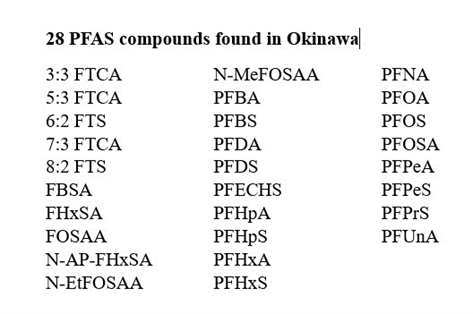Presenting data on PFAS contamination in Okinawa
By Pat Elder
November 6, 2023
Water drains from U.S. Marine Corps Camp Hansen into the sea at this site in Kin, Okinawa. We found 54 parts per trillion (ppt) of PFOS in the water here, meaning all aquatic life is poisoned. 20 years ago an Ornate Jobfish in Kin Bay was found to contain 7,900,000 ppt of PFOS here.
In mid-September, 2023 several groups of Okinawan activists and academics joined with us from the Veterans for Peace Speaking Tour to test surface waters for PFAS at 18 locations throughout the archipelago. Under the guidance of Rachel Clark, the Veterans for PeaceFP Speaking Tour has been touring Japan since 2016.
The results of our testing are laid out below. You can click on a location to see where it is on Google Maps. The results are presented from the highest to lowest values for total PFAS. The full results are at the end of this article.
# Location PFOS PFOA Total PFAS
5064 Kurashiki leachate 236.5 316 1,450.9
5070 Isa Ginowan Camp Zukeran wastewater 331.1 35.8 612.3
5043 Kin Town by the sea 54 5.9 95.3
5066 Yara Muruchi Kadena 40.4 4.4 87.3
5068 Chatan-Cho near Shiokawa Bridge 30.5 4.3 80.2
5061 Dakujaku River 24.1 2.4 48.9
5037 Kin Town by ammo depot* 8.2 15.8 45.6
5046 Urasoe Kowan River 12.5 1.4 19.7
5063 Uruma Okinawa near Camp Cortney 5.6 0 9.3
5067 Futenma Ginowan Futenma River 4.6 1.1 8.4
5065 Chatan-Cho Futenma River 3.5 1.3 6.8
5039 Urasoe Okinawa Minato River 4.5 0 6.3
5040 USMC Futenma Maehara Ginowan 2.4 2.6 5
5044 Urasoe 3 0 3
5036 Nago Henoko 0 0 3
5042 Hirae Ishigaki Island 0 1 2.2
5038 Yonaguni Island JSDF Camp Yonaguni 0 0 0
5035 Nago Camp Schwab 0 0 0
* GPS unavailable
PFOS and PFOA, two of the most widely reported PFAS compounds, make up 46% of the total PFAS concentrations in Okinawa.
Although other PFAS varieties are rarely reported in the Japanese media, we found 28 different PFAS compounds in the Okinawan environment, listed here.
The power of these chemicals
Four years ago Sharon Lerner of the Intercept interviewed Linda Birnbaum, former director of the U.S. National Institute for Environmental Health Sciences. Okinawa TV also interviewed Dr. Birnbaum. The influential piece quoted Birnbaum saying drinking water levels for PFOA should not exceed .1 part per trillion because of compelling research linking PFOA exposure to pancreatic cancer. It was a wakeup call on the power of these chemicals – all of these chemicals!
The EPA acted on Birnbaum’s warning and insituted an interim lifetime health advisory for PFOA in drinking water at .004 part per trillion. In this regard, the EPA is a champion of the science, and that’s great, although the agency still does not regulate PFAS in any environmental media. Japan follows the American lead and still does not forcefully regulate the chemicals.
Asked if there is a difference between eating or drinking PFAS contamination, Birnbaum explained, “No. Both are routes of ingestion. Whether you eat it or drink it, PFAS go to the same places in the body and do the same thing. We need appropriate fish advisories and regulations.”
Although PFOA is highly toxic and prevalent in Okinawa, PFOS poses a greater threat because of it bioaccumulates in fish.
Here, the greatest impact on human health from these chemicals is from the bioaccumulation of PFAS, especially PFOS - in food - especially fish.
Poisoned fish at Kadena Air Base
The Hija River drains Kadena Air Base in Okinawa. In 2016 fish were found in the river with PFOS levels from 22,000 ppt to 111,000 ppt. According to the research, the average PFOS value of 15 samples of fish analyzed in the Hija River basin was 64,000 ppt. The survey was conducted by Shuhei Tanaka, an associate professor at Kyoto University, and Hironori Suzuki, a researcher at the Public Works Research Institute.
Sword Tail 49,000 ppt to 102,000 ppt
Pearl Danios 43,000 ppt to 111,000 ppt
Guppy 35,000 ppt to 48,000 ppt
Tilapia 22,000 ppt to 100,000 ppt
The survey also included these results in some fish:
N-EtFOSE 584,000 ppt
6:2 FTS 190,000
8:2 FTS 7,800
N-EtFOSE is a 12-carbon chain PFAS compound and it could be in your Teriyaki Salmon. The compound increases liver weight in laboratory animals. We don’t know much about it, but we should. This is a glimpse into the evolving science of these ghastly chemicals.
In Japan a variety of PFAS compounds contaminate bream, carp, crab, filefish, flounder, jack mackerel, lugworm, medaka, mudskipper fish, mussel, oyster, porpoises, sandfish, sardines, sea bass, shark, and trout.
PFOS is found in the filet of fish from several hundred times the amount in the water, up to 2,000 times over. So, water with just 5 parts per trillion of PFOS may create a concentration of 10,000 ppt in certain species of fish, and sometimes even higher. PFOS is the champion of bioaccumulation in fish while PFOA in water gravitates to shellfish, like clams.
Regrettably, many of the alternative compounds used in place of the legacy PFOA and PFOS may also bioaccumulate in aquatic life.
The Camp Hansen sample taken from water draining into Kin Bay described above was also found to contain 17.7 ppt of PFHxS, a deadly chemical that bioaccumulates in fish.
PFHxS, in the smallest concentrations, is linked to:
Attention Deficit Disorder with Hyperactivity in children
Autism Spectrum Disorder
Decreased Birth Weight
Breast Neoplasms
Cognition Disorders in children
Diabetes Mellitus, Type 2
Dyslipidemia
Hepatomegaly
Hypertension
Liver Disease
Osteoporosis
PFNA also bioaccumulates in fish. It was found at 17 ppt in Chatan-Cho, not far from the Shiokawa Bridge. In the tiniest concentrations this chemical is associated with many of the diseases associated with PFHxS, including:
Asthma
Hepatocellular Carcinoma
Cholestasis
Hyperbilirubinemia
Perinatal Death
Delayed Puberty
PFHpA was found draining from wastewater from Camp Zukeran at a concentration of 18.7 ppt. This chemical is known for its association with gestational diabetes.
People who provide treatment for disease and cancer are heroes while those who point to the cause of disease and cancer are enemies of the state.
Here are our results:
Financial support from the Downs Law Group makes it possible for us to research and write about PFAS contamination in Japan and around the world.
The firm is working to provide legal representation to individuals in the U.S. and abroad with a high likelihood of exposure to trichloroethylene, PFAS, and other contaminants.
The Downs Law Group employs attorneys accredited by the Department of Veterans Affairs to assist those who have served in obtaining VA Compensation and Pension Benefits they are rightly owed.
If you spent time in the military and you think you may be sick as a result of your service, think about joining this group to learn from others with similar issues. Are you interested in joining a multi-base class action lawsuit pertaining to illnesses stemming from various kinds of environmental contamination?
Join the Veterans & Civilians Clean Water Alliance Facebook group. (2.5 K members and growing rapidly.)








